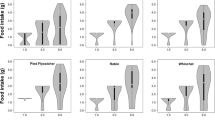Abstract
Long stretches of sea and desert often interrupt the migration routes of small songbirds, whose fat reserves must be restored before these can be crossed as they provide no opportunity for refuelling. To investigate whether magnetic cues might enable inexperienced migratory birds to recognize a region where they need to replenish their body fat, we caught and held thrush nightingales (Luscinia luscinia) in Sweden just before their first migration and exposed them to a magnetic field simulating that at a migratory stopover in northern Egypt, before the Sahara Desert. We found that this magnetic field stimulated the birds to extend their fat-deposition period, indicating that magnetic cues may help small migratory birds to confront large ecological barriers.
This is a preview of subscription content, access via your institution
Access options
Subscribe to this journal
Receive 51 print issues and online access
$199.00 per year
only $3.90 per issue
Buy this article
- Purchase on Springer Link
- Instant access to full article PDF
Prices may be subject to local taxes which are calculated during checkout

Similar content being viewed by others
References
Alerstam, T. Bird Migration (Cambridge Univ. Press, Cambridge, 1990
Gwinner, E. Ibis 138, 47–63 (1996).
Able, K. P. Trends Ecol. Evol. 8, 367–371 (1993).
Berthold, P. Control of Bird Migration (Chapman & Hall, London, 1996).
Lohmann, K. J. & Lohmann, C. M. F. Nature 380, 59–61 (1996).
Alerstam, T. & Lindström. Å. in Bird Migration: The Physiology and Ecophysiology (ed. Gwinner, E.) 331–351 (Springer, Berlin, 1990).
Kullberg, C., Fransson, T. & Jakobsson, S. Proc. R. Soc. Lond. B 263, 619–624 (1996).
Fry, C. H., Ash, J. S. & Ferguson-Lees, I. J. Ibis 112, 58–82 (1970).
Berthold, P. Trends Ecol. Evol. 6, 254–257 (1991).
Swedish Museum of Natural History, Bird Ringing Centre. Annual Reports of Swedish Bird Ringing 1960–98 (ISSN 0282-390X).
Thorup, K. & Rabøl, J. J. Avian Biol. 32, 111–119 (2001).
International Association of Geomagnetism and Aeronomy. Geophys. J. Int. 141, 259–262 (2000).
Lohmann, K. & Lohmann, C. M. F. J. Exp. Biol. 194, 23–32 (1994).
Author information
Authors and Affiliations
Corresponding author
Rights and permissions
About this article
Cite this article
Fransson, T., Jakobsson, S., Johansson, P. et al. Magnetic cues trigger extensive refuelling. Nature 414, 35–36 (2001). https://doi.org/10.1038/35102115
Issue Date:
DOI: https://doi.org/10.1038/35102115
This article is cited by
-
Avian navigation: the geomagnetic field provides compass cues but not a bicoordinate “map” plus a brief discussion of the alternative infrasound direction-finding hypothesis
Journal of Comparative Physiology A (2024)
-
Avian migration clocks in a changing world
Journal of Comparative Physiology A (2024)
-
Gauge-and-compass migration: inherited magnetic headings and signposts can adapt to changing geomagnetic landscapes
Movement Ecology (2023)
-
Sense of doubt: inaccurate and alternate locations of virtual magnetic displacements may give a distorted view of animal magnetoreception ability
Communications Biology (2023)
-
Inherited differences of migratory phenotypes in two Acrocephalus warblers in relation to geomagnetic field parameters
Behavioral Ecology and Sociobiology (2023)
Comments
By submitting a comment you agree to abide by our Terms and Community Guidelines. If you find something abusive or that does not comply with our terms or guidelines please flag it as inappropriate.



